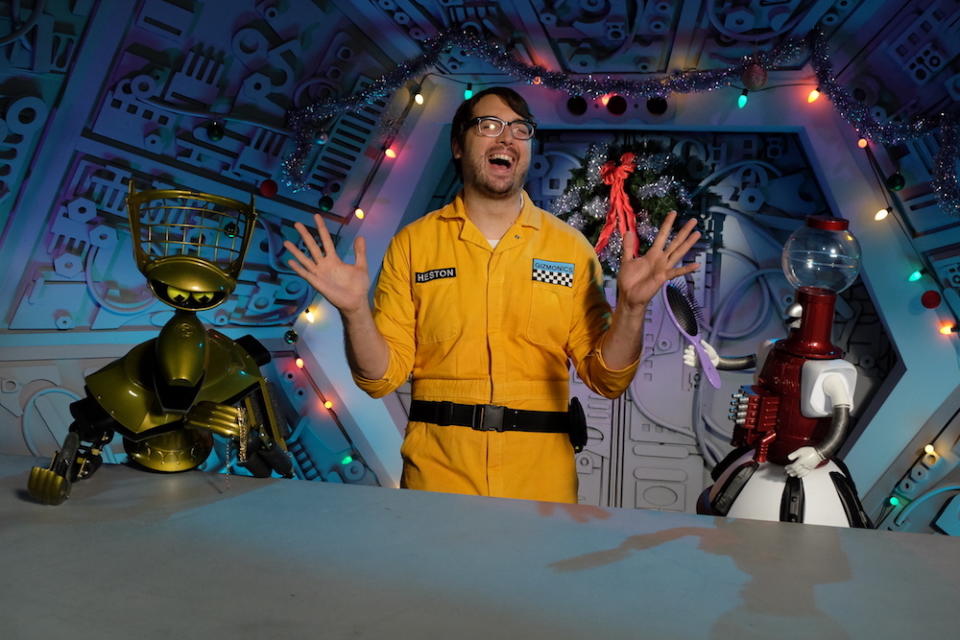‘Mystery Science Theater 3000: The Return’ Review: Faces Change, But The Anarchic Spirit Remains the Same

If you know the words, sing along:
If you’re wondering how he eats and breathes
and other science facts,
Just repeat to yourself, “It’s just a show,
I should really just relax…”
for Mystery Science Theater 3000!”
While some things have changed about the revival of “Mystery Science Theater 3000” (premiering this weekend on Netflix) an awful lot hasn’t — including the refrain above from the opening theme song, familiar to generations of fans. The lyrics above, a winky nod to the absurdity of the show’s premise, has always been a major tone-setter for the series created by Joel Hodgson, which brings together an appreciation for the clumsiest efforts in film history with its own crude yet charming style.
The 14-episode season, dubbed “The Return” as well as Season 11, introduces a number of new faces, most especially Jonah (Jonah Ray, familiar to any Nerdist podcast fans or the alt comedy world in general), a hapless Gizmonic Institute employee who gets abducted by the evil mad scientist Kinga Forrester (Felicia Day) and assistant Max (Patton Oswalt) to serve as the subject of her latest experiment. That experiment/justification for the show’s existence is to watch terrible movies for her sadistic pleasure. And Jonah, in the proud tradition of original hosts Joel (Hodgson) and Mike (Michael J. Nelson), copes by mocking the movies with some help from his robot friends.
Those robot friends look the same as before, but sound somewhat different thanks to new players as the voices for Crow T. Robot (Hampton Yount) and Tom Servo (Baron Vaughn). Fortunately, they’re still personality-wise the robots you might have grown up loving, and their relationship with Jonah has its own unique sparks.
As a lead, Ray’s most notable quality is a complete lack of cynicism — which might seem a little odd, given that the entire premise of the show revolves around brutal mockery of films. But somehow this good-hearted edge works for the series, and helps Ray stand out from the hosts who have come before.
Each episode focuses on one terrible film, with the runtimes kept to a tight 1:22-1:30 (about comparable to watching the original series on DVD). And boy, there are some real stinkers in the mix this season, including the Danish monster movie “Reptilicus,” the Rock Hudson/Mia Farrow mega-disaster movie “Avalanche” and “Star Wars” rip-off “Starcrash” (starring David Hasselhoff!).
Peppered in between the silhouetted sequences spent shouting at the screen are sketches, songs and some pretty notable guest stars, including Joel McHale, Jerry Seinfeld and Neil Patrick Harris (leading to a fun little “Dr. Horrible’s Sing-A-Long Blog” reunion with Day). Their presence speaks to the massive amounts of attention that this revival attracted thanks to the franchise’s long-standing popularity, which culminated in a massive Kickstarter campaign last year.

That crowd funding effort is worth noting because “MST3K: The Return” at times feels very conscious of the fact that it owes its existence to the fans who contributed (the initial production was completely independent, with Netflix coming in afterwards as a distribution partner) — and thus needs to hone as closely as possible to the original format that those fans loved: Direct address to the camera, props and sets that don’t hide their rough edges, and jokes that target a very specific sort of nerdity.
In fact, there’s a decision to adhere so closely to the original format that the producers have included commercial breaks… despite the fact that there are no commercials. Hodgson and company have their reasons for including these odd interstitials (which we’ll reveal in an upcoming interview with him and Ray) but they’re perhaps the roughest element of the show’s return, just because they stand out as odd.
At times, you might find yourself wondering what might have happened if the producers had freed themselves a bit more from the original format, experimented with tone and structure. But then it might perhaps not feel like “MST3K” anymore, and that would be the bigger crime.
There is one major evolution to the show, though — threaded throughout the episodes is more story than you might expect, and the season definitely ends with some major drama. This speaks to how Netflix distribution encourages serialization to a degree not possible during the show’s original run on networks like Comedy Central (and later, the Sci-Fi Channel), when episodes would air at random, and fans tuned in knowing that they wouldn’t need to have seen the previous episode to know what’s going on.
Technically, you could still watch this new season in a random order (as long as you began with the first episode and ended with the season finale), but the increase in serialization actually works nicely to tie the season together. Here’s what matters: Hosts may change, as will “the mads.” But as long as the movies remain bad and the quips come fast, “MST3K” will always be, above all else, indelibly itself. So you should really just relax.
Grade: A-
“Mystery Science Theater: The Return” is streaming now on Netflix.
Stay on top of the latest film and TV news! Sign up for our film and TV email newsletter here.
Related stories
'Mystery Science Theater 3000' Trailer: See Jonah Ray and Patton Oswalt in New Netflix Revival
'Mystery Science Theater 3000' Revival Gets First Look Photo, Netflix Release Date


